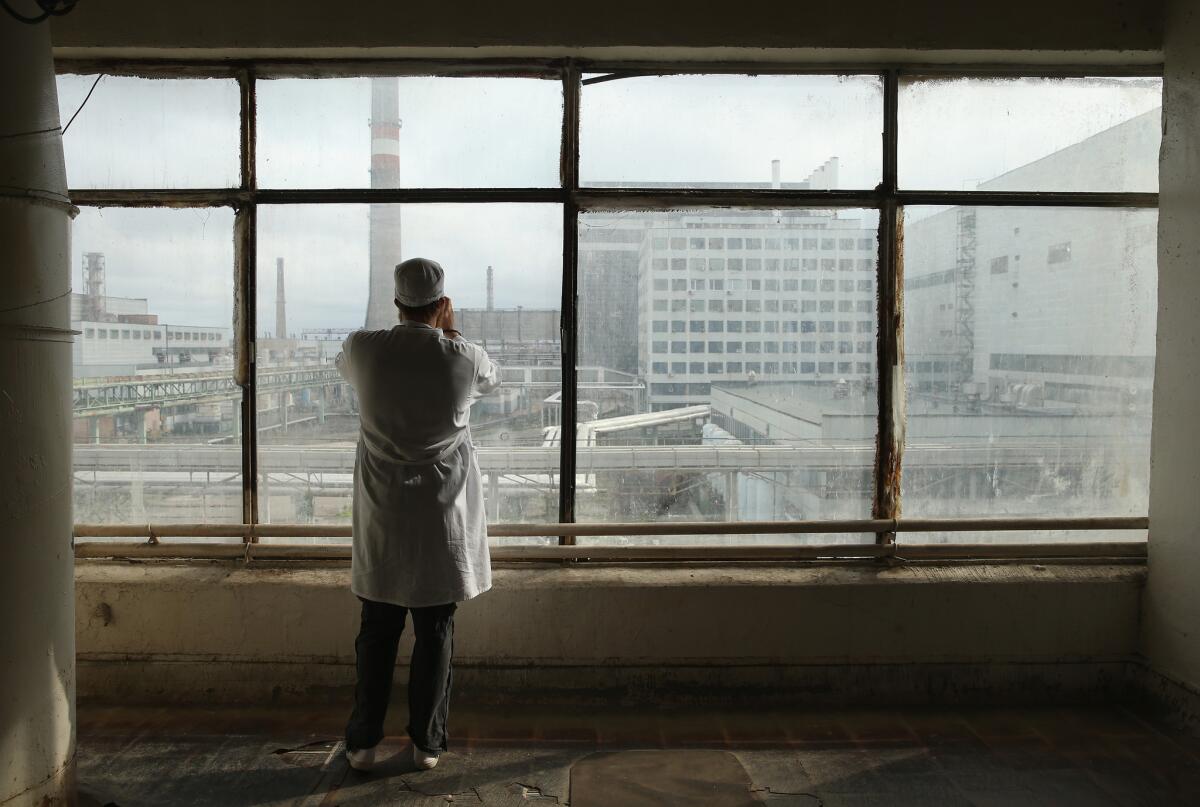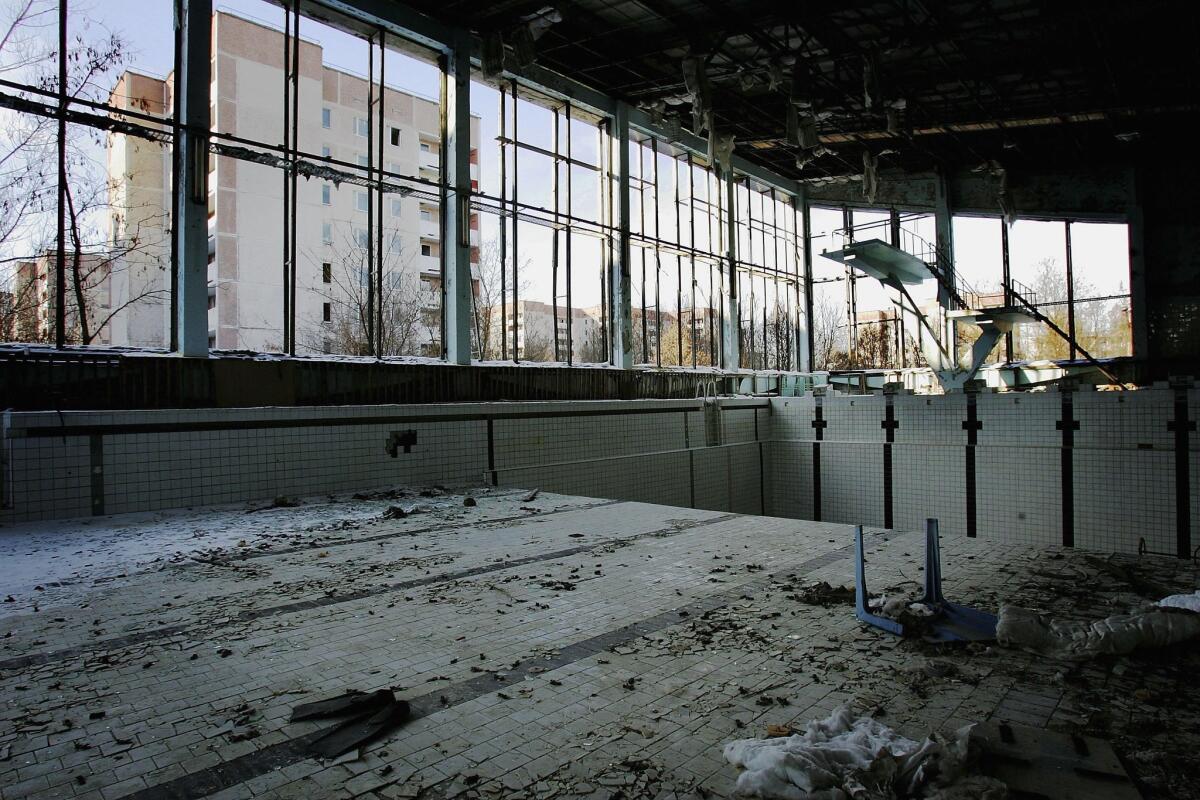Look Back | Chernobyl, 30 years after nuclear power plant disaster
- Share via
Thirty years ago, an explosion at the Chernobyl nuclear power plant in Ukraine released far more radioactivity than the atomic bombs dropped on Japan did, forcing the resettlement of more than 350,000 people. Scientists estimate that the most dangerous radioactive elements will take up to 900 years to decay sufficiently to render the area safe.

CHORNOBYL, UKRAINE - SEPTEMBER 29: A visitor touring the former Chernobyl nuclear power plant takes a photo through a window looking towards facilities that house reactors one and two on September 29, 2015 near Chornobyl, Ukraine. The Chernobyl plant is currently undergoing a decades-long decommissioning process of reactors one, two and three, which continued operation for years following the accident at reactor four. On April 26, 1986, technicians at Chernobyl conducting a test inadvertently caused reactor number four, which contained over 200 tons of uranium, to explode, flipping the 1,200 ton lid of the reactor into the air and sending plumes of highly radioactive particles and debris into the atmosphere in a deadly cloud that reached as far as western Europe. 32 people, many of them firemen sent to extinguish the blaze, died within days of the accident, and estimates vary from 4,000 to 200,000 deaths since then that can be attributed to illnesses resulting from Chernobyl’s radioactive contamination. Today large portions of the inner and outer Chernobyl Exclusion Zone that together cover 2,600 square kilometers remain contaminated. A consortium of western companies is building a movable enclosure called the New Safe Confinement that will cover the reactor remains and its fragile sarcophagus in order to prevent further contamination. (Photo by Sean Gallup/Getty Images)
(Sean Gallup / Getty Images)
Untouched:A visitor touring the former Chernobyl nuclear power plant takes a photo through a window looking towards facilities that house Reactors Nos. 1 and 2.
(Daniel Berehulak / Getty Images)
Reactor No. 4: The sarcophagus of Chernobyl Nuclear Reactor 4 is seen on Jan. 25, 2006.
(Daniel Berehulak / Getty Images)
Abandoned preschool: Beds in an abandoned preschool in the deserted town of Pripyat, Ukraine, next to the Chernobyl nuclear plant. Pripyat, where plant workers lived, and the surrounding area will not be safe for human habitation for several centuries.
(Sean Gallup / Getty Images)
Control room: A worker makes a phone call in the control room of Reactor No. 2 inside the former Chernobyl nuclear power plant.
(Sean Gallup / Getty Images)
Instrument panel: Instrument panels in the control room of Reactor No. 2 are nearly identical to those that were in the control room of Reactor No. 4, which blew up on April 26, 1986.

A pair of flippers lie in a swimming pool in the abandoned town of Pripyat near Chernobyl, Ukraine, on Jan. 24, 2006. Pripyat and the surrounding area will not be safe for human habitation for several centuries. Scientists estimate that the most dangerous radioactive elements will take up to 900 years to decay sufficiently to render the area safe.
(Daniel Berehulak / Getty Images)
Swimming pool: A pair of flippers remains in a deserted swimming pool in the abandoned town of Pripyat, Ukraine.
(Sergei Supinsky / Getty Images)
Hotel room: Paint peels in a hotel in Pripyat, adjacent to the Chernobyl nuclear site.
(Sergei Supinsky / Getty Images)
Amusement park : An abandoned amusement park in the ghost town of Pripyat, where workers at the nuclear plant once lived.
(Sean Gallup / Getty Images)
Memorial: Visitors photograph a memorial to worker Valery Khodemchuk at a wall that separates Reactors 3 and 4 inside the plant. Khodemchuk was a circulating-pump operator killed in the accident; his body remains entombed inside Reactor No. 4.
(Sean Gallup / Getty Images)
Warning signs: A sign warns of radiation contamination and prohibits the picking of berries and mushrooms near Chachersk, Belarus. Chachersk, in southeastern Belarus, is in a zone still designated as contaminated with radiation from the 1986 Chernobyl disaster.
(Sean Gallup / Getty Images)
Guided tour: Tourists on a guided tour snap photos of one another outside an abandoned shop and apartment building in Pripyat, Ukraine. Pripyat, built in the 1970s as a model Soviet city to house the workers of the Chernobyl nuclear power plant and their families, now stands abandoned inside the Chernobyl Exclusion Zone.
(Sean Gallup / Getty Images)
Screening: A worker applying for a job at the Chernobyl nuclear power plant prepares to undergo screening for radiation levels in his body at the National Research Center for Radiation Medicine, a hospital and research institute established in Kiev, Ukraine, after Chernobyl disaster.
(Daniel Berehulak / Getty Images)
Radiated: Highly radiated helicopters used to dump concrete and water on Reactor No. 4 during the 1986 catastrophe lay in a field near the Ukrainian village of Rosoha.
(Daniel Berehulak / Getty Images)
Nuclear hazard signs: Nuclear hazard signs are seen in the village of Kopachi, Ukraine. Kopachi was one of the many villages close to Chernobyl plant that were buried soon after the catastrophe to avoid further radioactive contamination.
Sign up for The Wild
We’ll help you find the best places to hike, bike and run, as well as the perfect silent spots for meditation and yoga.
You may occasionally receive promotional content from the Los Angeles Times.



